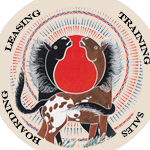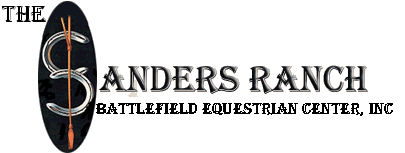| |
Boarding
We are primarily a boarding facility and most of our
focus centers on the care and well being of your horse. We
live on  the
premises and have done so since May, 1983. We are here
most of the time, in that, both Kim and I work and live here. We
try to run a 'Mom and Pop' operation (with help from friends and
family) but run it well and, as a result, we have enjoyed a solid
reputation for 'Quality Care' for many years. We have our own
horses here too and treat yours as well as we treat our own. We
limit our facility to our clients and their guests. We do
not lease horses by the hour (although we do LEASE horses
by the YEAR), nor do we invite the general public
for lessons or any other activities. We are not a 'show barn',
although some of our boarders do show their horses. We tend
to attract a variety of clientele, mostly adults, people from all
walks of life. Interestingly, a large segment of our boarders
are 'Baby Boomers' that always wanted a horse when they were children
and can now afford one... it is their pet, companion... strong bonds
form and it becomes a rewarding experience for them. These
are the people that tend to stay with us the longest. In the
18 years we have been here, we have never missed a feeding. We
have taken vacations, but trusted and knowledgeable people have been
left to operate the facility and stay in our house. Lastly,
we have from 2 to 5 foals born each year. For the most part
this is not a profitable venture as we pay the stud fee, raise, train,
feed, inoculate, worm, etc. But, we have found that it is
an aesthetic attribute to the place. Many of our clients look
forward to each foal being born and watching them during their first
week and watching them through various phases. the
premises and have done so since May, 1983. We are here
most of the time, in that, both Kim and I work and live here. We
try to run a 'Mom and Pop' operation (with help from friends and
family) but run it well and, as a result, we have enjoyed a solid
reputation for 'Quality Care' for many years. We have our own
horses here too and treat yours as well as we treat our own. We
limit our facility to our clients and their guests. We do
not lease horses by the hour (although we do LEASE horses
by the YEAR), nor do we invite the general public
for lessons or any other activities. We are not a 'show barn',
although some of our boarders do show their horses. We tend
to attract a variety of clientele, mostly adults, people from all
walks of life. Interestingly, a large segment of our boarders
are 'Baby Boomers' that always wanted a horse when they were children
and can now afford one... it is their pet, companion... strong bonds
form and it becomes a rewarding experience for them. These
are the people that tend to stay with us the longest. In the
18 years we have been here, we have never missed a feeding. We
have taken vacations, but trusted and knowledgeable people have been
left to operate the facility and stay in our house. Lastly,
we have from 2 to 5 foals born each year. For the most part
this is not a profitable venture as we pay the stud fee, raise, train,
feed, inoculate, worm, etc. But, we have found that it is
an aesthetic attribute to the place. Many of our clients look
forward to each foal being born and watching them during their first
week and watching them through various phases.
Specifics
Boarding is by the month with a
30-day notice from the 1st of the month required. We do not
publish rates here as they are subject to change. Please CONTACT
US for further information.
We feed every morning at about 5 AM and every
evening at 5 PM. We do not have field board. Full
board includes up to 3 lbs of 'sweet' feed at each of the 2 daily feedings
(6AM and 5PM). Additional feed is available at additional cost. It
also includes 20 lbs of hay per horse in the winter. The hay is stored
in a separate barn, 100 feet away from the other barns, a significant safety
feature for the horses.
We have about 50 stalls for boarding. These
are 12' x 12' box stalls in two separate barns. Since we have plenty
of room, all horses are turned out in the spring, summer and fall unless they
are injured or in isolation. Turnout in the winter is left up to the
owner. All
new horses coming in must have a current coggins and will remain in one of
our isolation fields for 2 weeks during which time it may not come in contact
with any other horse.
 The horses have the run of the place, which
is split roughly in half into 2 pastures of approximately 50-60 acres each
(the rest being forest shelter). We believe firmly that the mares and
geldings should be allowed to be together and try to allow the 'herd' to be what
it would be if it were in the wild. We find that we have dominant
geldings and dominant mares and the herd is very stable. The only instability
occurs when we introduce a new horse which, depending on the new horse, is
either uneventful, or it takes a week or two for the new horse to find its
place in the pecking order. All new horses coming in spend 2 weeks in
isolation, and then we put them in a field that allows them to touch noses
over the board fencing for a few days before it is allowed to run free with
the herd. We
do the same thing with our foals. They spend a while with their dams
in fields away from the herd, then we put the dam, the foal and that dams dominant
gelding or mare in a field next to the herd for a while, then we put them all
back together again. This makes for a very natural environment for all
the horses, as it is most similar to what they would experience we they not
so domesticated. We believe that this also contributes positively to
their mental a physical well-being. The horses have the run of the place, which
is split roughly in half into 2 pastures of approximately 50-60 acres each
(the rest being forest shelter). We believe firmly that the mares and
geldings should be allowed to be together and try to allow the 'herd' to be what
it would be if it were in the wild. We find that we have dominant
geldings and dominant mares and the herd is very stable. The only instability
occurs when we introduce a new horse which, depending on the new horse, is
either uneventful, or it takes a week or two for the new horse to find its
place in the pecking order. All new horses coming in spend 2 weeks in
isolation, and then we put them in a field that allows them to touch noses
over the board fencing for a few days before it is allowed to run free with
the herd. We
do the same thing with our foals. They spend a while with their dams
in fields away from the herd, then we put the dam, the foal and that dams dominant
gelding or mare in a field next to the herd for a while, then we put them all
back together again. This makes for a very natural environment for all
the horses, as it is most similar to what they would experience we they not
so domesticated. We believe that this also contributes positively to
their mental a physical well-being.
We rotate our pastures and chain harrow the
just vacated pasture for parasite control and sound pasture maintenance. We
worm all the horses at the same time, again for parasite control. We
worm 6 times per year and vaccinate 3 times per year. We use Ivermectin
every other wormer with Panacur and Strongid in between. We vaccinate
for Rhino, Rabies, 4 in 1 (tet/flu/ewee), Potomac Fever, Strangles and booster
the Flu and Rhino. And, of course, a coggins is drawn on every horse
once per year. The
owner bears this expense but we handle it in a clinic fashion, thus significantly
reducing the cost to the owner.
|



